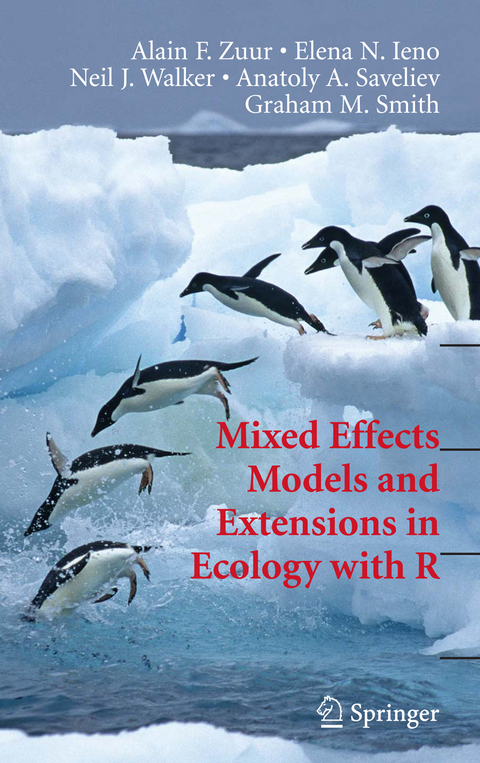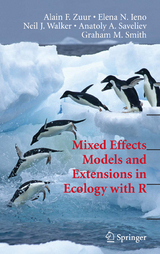Mixed Effects Models and Extensions in Ecology with R
Springer-Verlag New York Inc.
978-0-387-87457-9 (ISBN)
Limitations of Linear Regression Applied on Ecological Data.- Things are not Always Linear; Additive Modelling.- Dealing with Heterogeneity.- Mixed Effects Modelling for Nested Data.- Violation of Independence – Part I.- Violation of Independence – Part II.- Meet the Exponential Family.- GLM and GAM for Count Data.- GLM and GAM for Absence–Presence and Proportional Data.- Zero-Truncated and Zero-Inflated Models for Count Data.- Generalised Estimation Equations.- GLMM and GAMM.- Estimating Trends for Antarctic Birds in Relation to Climate Change.- Large-Scale Impacts of Land-Use Change in a Scottish Farming Catchment.- Negative Binomial GAM and GAMM to Analyse Amphibian Roadkills.- Additive Mixed Modelling Applied on Deep-Sea Pelagic Bioluminescent Organisms.- Additive Mixed Modelling Applied on Phytoplankton Time Series Data.- Mixed Effects Modelling Applied on American Foulbrood Affecting Honey Bees Larvae.- Three-Way Nested Data for Age Determination Techniques Applied to Cetaceans.- GLMM Applied on the Spatial Distribution of Koalas in a Fragmented Landscape.- A Comparison of GLM, GEE, and GLMM Applied to Badger Activity Data.- Incorporating Temporal Correlation in Seal Abundance Data with MCMC.
From the reviews:"For many people dealing with statistics is like jumping into ice-cold water. This metaphor is depicted by the cover of this book … . full of excellent example code and for most graphs and analyses the code is printed and explained in detail. … Each example finishes with … valuable information for a person new to a technique. In summary, I highly recommend the book to anyone who is familiar with basic statistics … who wants to expand his/her statistical knowledge to analyse ecological data." (Bernd Gruber, Basic and Applied Ecology, Vol. 10, 2009)"This book is written in a very approachable conversational style. The additional focus on the heuristics of the process rather than just a rote recital of theory and equations is commendable. This type of approach helps the reader get behind the ‘why’ of what’s being done rather than blindly follow a simple list of rules.… In short, this text is good for researchers with at least a little familiarity with the basic concepts of modeling and who want some solid stop-by-stop guidance with examples on how common ecological modeling tasks are accomplished using R." (Aaron Christ, Journal of Statistical Software, November 2009, Vol. 32)"The authors succeed in explaining complex extensions of regression in largely nonmathematical terms and clearly present appropriate R code for each analysis. A major strength of the text is that instead of relying on idealized datasets … the authors use data from consulting projects or dissertation research to expose issues associated with ‘real’ data. … The book is well written and accessible … . the volume should be a useful reference for advanced graduate students, postdoctoral researchers, and experienced professionals working in the biological sciences." (Paul E. Bourdeau, The Quarterly Review of Biology, Vol. 84, December, 2009)“This is a companion volume to Analyzing Ecology Data by thesame authors. …It extends the previous work by looking at more complex general and generalized linear models involving mixed effects or heterogeneity in variances. It is aimed at statistically sophisticated readers who have a good understanding of multiple regression models… .The pedagogical style is informal… . The authors are pragmatists—they use combinations of informal graphical approaches, formal hypothesis testing, and information-theoretical model selection methods when analyzing data. …Advanced graduate students in ecology or ecologists with several years of experience with ‘messy’ data would find this book useful. …Statisticians would find this book interesting for the nice explorations of many of the issues with messy data. This book would be (very) suitable for a graduate course on statistical consulting—indeed, students would learn a great deal about the use of sophisticated statistical models in ecology! …I very much liked this book (and also the previous volume). I enjoyed the nontechnical presentations of the complex ideas and their emphasis that a good analysis uses ‘simple statistical methods wherever possible, but doesn’t use them simplistically.’” (Biometrics, Summer 2009, 65, 992–993)“This book is a great introduction to a wide variety of regression models. … This text examines how to fit many alternative models using the statistical package R. … The text is a valuable reference … . A large number of real datasets are used as examples. Discussion on which model to use and the large number of recent references make the book useful for self study … .” (David J. Olive, Technometrics, Vol. 52 (4), November, 2010)
| Erscheint lt. Verlag | 12.3.2009 |
|---|---|
| Reihe/Serie | Statistics for Biology and Health |
| Zusatzinfo | XXII, 574 p. |
| Verlagsort | New York, NY |
| Sprache | englisch |
| Maße | 155 x 235 mm |
| Themenwelt | Naturwissenschaften ► Biologie ► Ökologie / Naturschutz |
| ISBN-10 | 0-387-87457-7 / 0387874577 |
| ISBN-13 | 978-0-387-87457-9 / 9780387874579 |
| Zustand | Neuware |
| Haben Sie eine Frage zum Produkt? |
aus dem Bereich




